Let’s clear up one common misconception from the get-go: Self-care is not synonymous with self-indulgence or being selfish. Self-care means taking care of yourself so that you can be healthy, you can be well, you can do your job, you can help and care for others, and you can do all the things you need to and want to accomplish in a day.
If you think you’ve been hearing more about self-care lately, you’re right. One indicator: According to Google Trends, the number of searches for “self-care” has nearly quadrupled since 2018.
Paula Gill Lopez, PhD, an associate professor in the department of psychological and educational consultation at Fairfield University in Fairfield, Connecticut, says the need is obvious. “We have an epidemic of anxiety and depression,” she says. “Everybody feels it.”
Self-care is part of the answer to how we can all better cope with daily stressors, explains Kelsey Patel, a Los Angeles-based wellness expert. It’s work stress. It’s the stress of trying to keep up with the pace of daily life, which technology has hastened more than ever (just think how many emails come flooding into your inbox each day). “People are feeling lonelier and less able to unwind and slow down, which makes them feel more anxious and overwhelmed by even the simplest tasks,” Patel says.
What Is Self-Care, and Why Is It Critical for Your Well-Being?
Several organizations and researchers take a health-oriented approach when defining self-care. The World Health Organization defines self-care as: “the ability of individuals, families, and communities to promote health, prevent disease, maintain health, and cope with illness and disability with or without the support of a health worker.”
According to this definition, it includes everything related to staying physically healthy — including hygiene, nutrition, and seeking medical care when needed. It’s all the steps an individual can take to manage stressors in his or her life and take care of his or her own health and well-being.
What Is Self-Care?
Self-care is anything you do to take care of yourself so you can stay physically, mentally, and emotionally well. Its benefits are better physical, mental, and emotional health and well-being. Research suggests self-care promotes positive health outcomes, such as fostering resilience, living longer, and becoming better equipped to manage stress.
Some researchers have adopted a similarly clinical approach. A 2010 study defined self-care as “the set of activities in which one engages throughout life on a daily basis,” focusing on promoting health, preventing illness, and managing issues that come up.
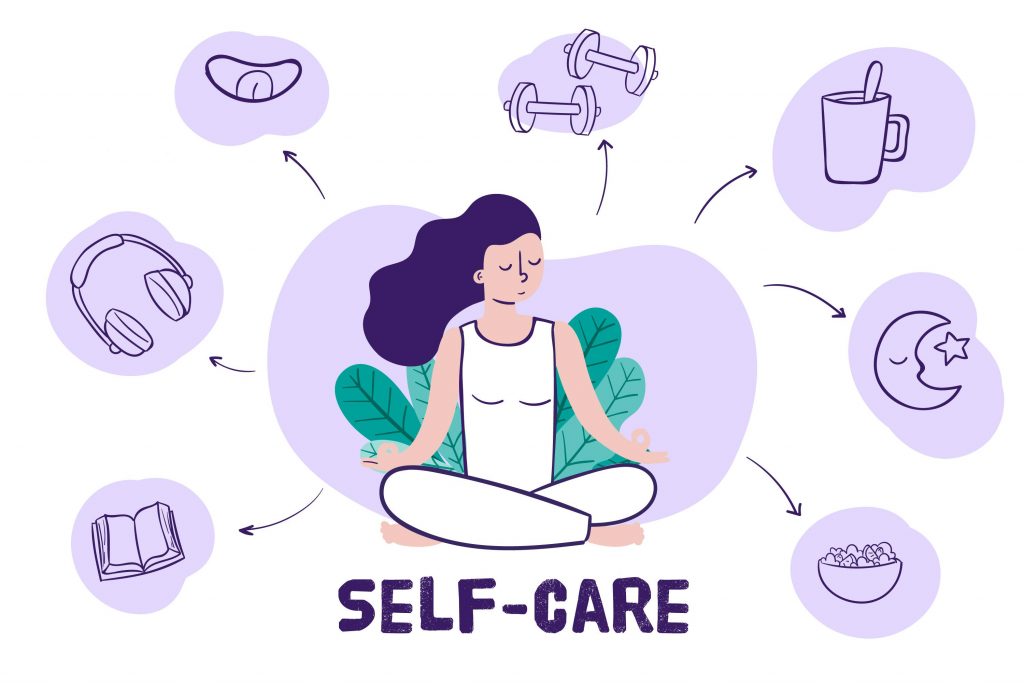
A study published in 2018 took self-care to mean “the self-initiated behavior that people choose to incorporate to promote good health and general well-being.” The study authors added that it’s about being healthy but also about incorporating coping strategies to deal with work stressors.
In 2019, researchers published a framework to specifically point out that in addition to self-care being the activities individuals do on their own to promote physical and emotional health, it also includes the ways that individuals interact with clinicians and healthcare systems to tend to physical and emotional health. That means it includes things like getting a vaccine, scheduling cancer screenings, or taking prescription medications on schedule — but healthcare providers and organizations play a role, too, in how well individuals engage in these practices. In other words: There are a lot of people and factors that bear on any individual’s ability to engage in self-care.
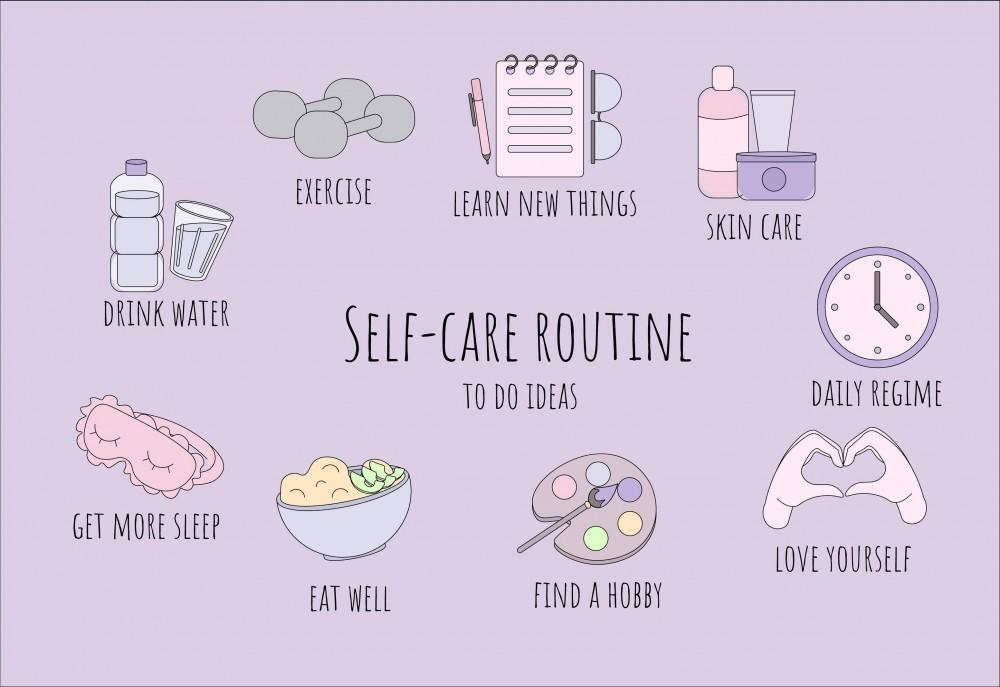
As self-care has become more mainstream, the definitions have started to become more about general wellbeing and tend to focus on tuning in to one’s needs and meeting those needs. “Self-care is anything that you do for yourself that feels nourishing,” says Marni Amsellem, PhD, a licensed psychologist based in the greater New York metropolitan area.
“That can be something that’s relaxing or calming, or it can be something that is intellectual or spiritual or physical or practical or something you need to get done,” she says.
The International Self-Care Foundation also includes health literacy as a pillar of self-care, meaning that any steps you take toward better understanding health information you need to make appropriate decisions about your health and well-being counts as self-care, too.
Self-care requires checking in with yourself and asking yourself how you’re doing physically, mentally, and emotionally. Some people use it to deal with difficult news stories, while others practice it just to maintain their happiness day to day. Self-care does not mean the same thing for everyone. Different people will adopt different self-care practices, and even your own definition might change over time. “What is self-care for one person will likely differ from someone else, and what’s self-care for you one day might not feel like self-care another day,” Dr. Amsellem says.
Engaging in self-care regularly could help you put your best foot forward. “When we are regularly taking care of ourselves, we are better able to react to the things that go on in our lives,” Amsellem says. “It’s something we do to maintain positive well-being.”
Types of Self-Care
“It could be anything that floats your boat — anything that puts a smile on your face,” Dr. Gill Lopez says. “Anything that makes you feel cared for, even if it’s you caring for yourself.”
There are a few different categories of self-care:
- Emotional self-care, such as self-talk, weekly bubble baths, saying “no” to things that cause unnecessary stress, giving yourself permission to take a pause, or setting up a weekly coffee date with a friend
- Physical self-care, such as prioritizing sleep, adopting an exercise routine you can stick with, or choosing healthy and nourishing foods over highly processed ones
- Spiritual self-care, such as attending a religious service, spending time in nature, meditating, incorporating regular acts of kindness into your day, or keeping a gratitude journal
Additionally, Gill Lopez puts self-care into two further categories: temporary and enduring.
What Counts as Self-Care, and What Doesn’t
There’s no way to say exactly what counts as self-care because everyone’s definition is their own and unique.
The underlying rule is that it’s something that brings you sustained joy in the long run. And though there are plenty of examples of self-care that seem to tread a fine line between a health-enhancing behavior and self-indulgence, self-care doesn’t have to be about padding your calendar with luxurious experiences or activities that cost money (though it certainly can).
Consider a manicure or a massage or any other pampering activity. It might seem indulgent, but if the activity helps you de-stress and carve out time for yourself, it counts as self-care, Amsellem says. If weekly manicures or monthly spa days are beyond your means, they will likely add stress to your life in the long run, so there are plenty of other self-care practices you can adopt.
“Self-care does not have to cost anything — it’s just doing things you enjoy. And a lot of the things we enjoy or feel fulfilled from cost nothing,” Amsellem says. “Stepping outside and taking a deep breath, for example, might be the greatest act of self-care.”
Even if you can’t spend lots of time and money, Gill Lopez says you can still practice self-care several times a week by turning things you do every day into self-care practices.
Maybe you try being more mindful of your thoughts on your commute, or maybe you find ways to make daily tasks, like showering, more enjoyable. Pick a soap with a scent that you love, and focus on the physical sensations of the shower. Gill Lopez says: What does your shower smell like? What does it sound like? How does the warm water feel on your skin? “For about 10 minutes in the shower, which I have to do anyway, instead of letting my monkey brain run wild, I’m right there,” she says.
Daily chores like making your bed in the morning are also examples of self-care — or can be. “This is where that individuality comes into play, because for some people there is no way making a bed feels like self-care — it may just feel like a chore,” Amsellem says. But if it helps you claim your day and gives you a sense of accomplishment early on, you’ll have that with you even if the rest of the day gets derailed, Amsellem says.
The simple act of making your bed in the morning likely isn’t sufficient to account for all your self-care, she says. You may need to routinely devote time and energy to other self-care practices, she adds. “But if there are some days when you feel out of control, on those days, starting the day off doing what you wanted to do for yourself might be one of the biggest forms of self-care you engage in that day.”
And sometimes when all of our other self-care plans get thrown out of whack (you worked through your yoga class, your friend canceled your coffee date — we’ve all been there), it’s those small practices of self-care that provide just enough calm to help us get through the day and wake up in a better mood tomorrow.
The Effects: How Self-Care Benefits Your Health and Well-Being
Many common self-care practices have been linked to longevity and other positive health outcomes, says Ellen K. Baker, PhD, a psychologist based in Washington, DC. There’s a lot of research, for example, showing that things like exercise, yoga, and mindfulness are supportive of mental and physical health, she says.
An article published in 2020 noted that longevity in the 21st century depends on abiding by healthy practices — such as exercising, not smoking, and following a healthy diet — and also embracing a positive lifestyle all around. Paying attention to your well-being involves asking yourself big questions (such as “What brings me satisfaction?”) and then finding ways to get there.
The following self-care practices have been well-researched and linked to a longer life:
- Exercise People who exercised between two and eight hours per week throughout their lives reduced their risk of an early death by 29 to 36 percent.
- Finding Purpose According to the researchers behind a 2019 study, having a strong life purpose was associated with decreased mortality rates.
- Diet Eating a diet filled with more servings of fruits and vegetables per day was associated with a lower risk of mortality, especially from heart-related issues.
- Sleep A study published in 2017 found too little sleep (less than seven hours per night) was linked with higher mortality rates, though too much sleep wasn’t healthy either.
- Getting Outside According to a 2019 study, spending time in green space is associated with a lower mortality rate.
The clinical evidence documenting the long-term health benefits of specifically taking a self-care approach to health (over other approaches) is less robust, but it is building.
For instance, research shows that people with chronic conditions who were more likely to follow medication regimens, to be knowledgeable about how to take care of their health, and to have the skills to take care of their health (characteristics that are considered part of self-care) were more likely to score higher when it came to measures of mental and physical functioning.
How to Start a Self-Care Routine
To get started with a self-care routine:
- Determine which activities bring you joy, replenish your energy, and restore your balance.
- Start small by choosing one behavior you’d like to incorporate into your routine in the next week.
- Build up to practicing that behavior every day for one week.
- Reflect on how you feel.
- Add more practices when ready.
- Get support through sharing practices from loved ones, a coach, a licensed professional (like a therapist or dietitian), or through your healthcare plan, community, or workplace.
Practicing self-care doesn’t need to be a heavy lift right out of the gate. Here are a few ideas to ease you into your self-care journey:
- Journal.
- Start each day by paying attention to your breath for five minutes and setting intentions for the day.
- Eat breakfast.
- Reflect on what you’re grateful for each night.
- Put your phone on airplane mode for a half hour before bed each night to release yourself from the flurry of notifications.
- Call a friend just to say hello.
- Take up a relaxing hobby.
- Pick a bedtime, and stick to it.
Note: If you read this and feel a sense of demoralization or sadness from the challenges of mounting or establishing a self-care practice, it’s best to get help and support. There may be barriers to caring for yourself from past trauma, mental health issues, or family situations that may be making it more challenging to get started. Seek support from trusted counselors and behavioral health providers (like a therapist), a trusted primary care doctor, or a close friend.
The bottom line: Self-care can have a positive effect on your health and outlook, but it requires a commitment or intention to invest in your well-being.
Its name makes it sound like a silly playground game, but pickleball has become a seriously popular sport, especially with older adults. Pickleball stretches and exercises are important for your health.
The game, which is played with a paddle on a 20-by-44-foot court, has been described as a combination of tennis, ping pong and badminton. There’s a common misconception that pickleball is not as strenuous as tennis, but it can be, especially if you’re very competitive. Before you play, you still need to take precautions and warm up like you would with any other sport.
For anyone who is new to pickleball and hasn’t been very active, it is advised to slowly ramp up the amount of time spent playing. Cross-training to help to build up cardiovascular endurance, is recommended. Swimming and stationary cycling are both great for older people, because they are easy on the joints.
Even if you take the right pre-game steps, pickleball-related injuries can still happen. Here, we highlight the most frequent pickleball injuries that are seen among physical therapy patients, some exercises and stretches that can help prevent them and how to treat them when they happen.
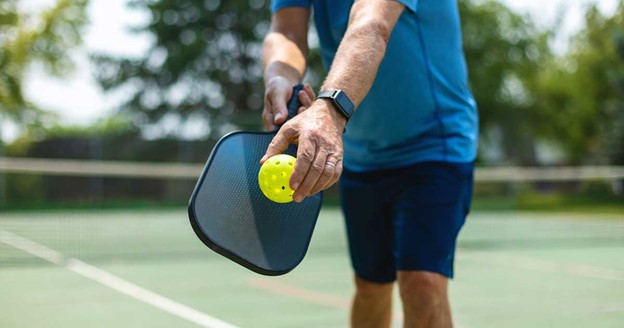
Ankle sprain
Ankle sprains are the most common pickleball injury. Pickleball is similar to tennis in that it requires a lot of running and sudden stopping and a lot of side-to-side movements. If your ankle stabilizer muscles are not strong enough, you increase the risk of twisting your ankle.
If you do twist your ankle, you should ice it as soon as you can. You may also want to wrap it with an elastic bandage or use an ankle support sleeve, which can be purchased at a drugstore. Bandaging it provides compression, which helps keep the swelling down. Elevating the injured ankle can also help, as can taking an over-the-counter pain medication like Tylenol or Advil.
Move to try: Heel Raises
Controlled heel raises help to strengthen your ankles.
- Hold on to a counter or table for balance.
- Stand with your feet about hip-width apart and your toes pointing forward.
- Slowly raise your heels as high as they can go, then lower them just as slowly. Do this several times.
Knee strain
Because pickleball is popular among older people, a lot of players have underlying arthritis in their knees. The twisting and pivoting movements that happen on the court can often aggravate knee arthritis. You may have a sharp, stabbing pain or a momentary feeling of weakness.
Similar to an ankle sprain, if you strain or twist your knee it’s important to bring the inflammation down. Ice and over-the-counter pain medications can help control swelling, and an elastic bandage or knee brace can provide support.
Move to try: Side-Lying Leg Lift
The side-lying leg lift is particularly helpful for preventing knee injuries because it works the entire leg, all the way up to the hip. Building overall leg strength helps protect the knees.
- Lie on your side, then lift your top leg keeping the knee straight and position it slightly behind you. Keep your hips stacked on top of each other and engage your core.
- Slowly lower your leg before lifting it again. If you feel it in your butt — your glutes — you know you’re doing it right.
- Repeat several times, then switch sides.
Pulled hamstring
It’s very important to stretch and warm up your muscles before playing pickleball. The hamstrings, or muscles in the backs of your thighs, may get stretched too far or become strained, especially if you’re not warmed up. These injuries often happen during sudden stops on the court, when the muscles contract quickly.
As with other injuries of the lower extremities, icing the injury and taking over-the-counter pain medications are key to feeling better. With any of these injuries, if the pain persists longer than a week or if you can’t put any weight on the injured leg, you may want to see a healthcare provider.
Move to try: Hamstring Stretch
This warm-up stretches your calves as well as your hamstrings.
- Standing with both feet side by side, extend your left leg in front of you so that your heel is on the ground with your toes pointing up.
- Bend your right knee and hinge at the waist so that your torso angles forward. You should feel a stretch in the back of your thigh.
- Hold for 30 seconds, then switch sides and repeat. Additionally, a slow jog in place can help increase blood flow to the leg muscles before starting a game.
Tendonitis in the wrist, elbow or shoulder
Tendonitis, an inflammation or swelling of the tendons, is an injury caused by overuse. When you hit the ball in pickleball, you don’t use as much force as you do with tennis because the ball is much lighter, but if you’re new to the game or if you’re playing a lot, the repetitive motion can put stress on your tendons.
Especially if you’re just starting out with pickleball and have not regularly played other racquet sports, it’s important to give yourself a day or two of recovery between sessions. Once your muscles get used to the movements, you might be able to play more often.
Similar to injuries in the lower extremities, ice and pain medications can help to reduce inflammation and speed healing. For injuries caused by repetitive motion, rest is especially important in helping your body heal.
Injuries related to falls
When you fall, it’s natural to use your hands to catch yourself. This can result in injuries to the hand, wrist or shoulder. If you have a lot of pain, it’s probably better to see the doctor and get an x-ray sooner rather than later to make sure nothing is broken.
If you fall while playing pickleball, you may also hit your head. If you feel anything out of the ordinary, including blurry vision, a sense of confusion, or extreme sleepiness, it’s important to it checked out to make sure you don’t have a serious injury like a concussion.
Move to try: Single-Leg Balance
The best way to prevent falling is to improve your balance.
- Stand with both feet hip-width apart without holding onto anything for support.
- Lift one foot off the ground. Hold your arms out to the sides if you need help balancing.
- Hold for as long as possible, up to a minute on each side. Once you’ve mastered that, you can try standing on something uneven like a pillow or a folded-up blanket.
YOU CAN DO BY YOURSELF THIS WINTER
Anyone bitten by the pickleball bug knows that half the joy of playing is the community and camaraderie we share with the groups we play with. Even an “off” day on the court is still filled with smiles, laughs, and jokes with our partners and opponents.
For the players in warm locales, there’s no off-season for the pickleball addiction. However, when the winter arrives (or already here) we have to find a way to keep up. While some might be fortunate to have an indoor spot to play weekly, for most of us it means less pickleball- or no pickleball at all! As gut-wrenching as that is to say, it doesn’t mean we can’t use this time to stay sharp and improve our games.
So, here are 4 pickleball drills anyone can do to improve their play during the winter. All of these drills can be modified to the space you do have- whether it be an open room in the basement, a garage door, or braving the cold for some time off the backboard of a local court.
1. WALL DINKS
The first pickleball drill is Wall Dinks. Two observations- 1) every time I watch the pros, I’m stunned at how precise they are and how rarely they come up short on their dinks, and 2) I can’t think of any greater frustration in my own game than when I mis-hit a dink and leave it short! So, what could be a better use of practice time than working on your dinking? If you generally work from home a couple of days a week, in lieu of a post-lunch afternoon walk, on pleasant days, you can start taking your paddle and a ball to a park adjacent to your house with a tennis backboard. Start each session hitting 100 dinks with your forehand and 100 dinks backhand…you’d be amazed at how much it will improve your dinking during games. Add a “target” for increased precision, and it’s stunning how fast you can get a lot of dink work in. As a bonus, when you dink off a wall, you really have to exaggerate bending your knees and getting into your legs or you’ll quickly end up with a sore back.
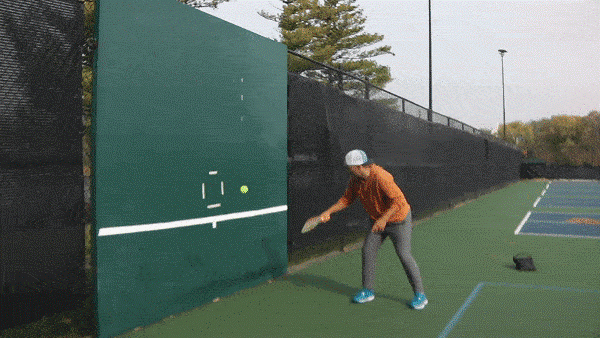
2. WALL VOLLEYS
The second pickleball drill is Wall Volleys. Other than a well-executed Erne or ATP, there’s probably nothing much more satisfying than winning a hands battle at the kitchen line. However, we’d venture to guess that this is one thing that most of us aren’t practicing regularly. Along with the dinking routine noted above, another drill you can take to practicing on lunch breaks is volleying the ball off the wall. Try to get to 100 in a row (which is hard), and generally don’t stop until you at least keep in the air 30 consecutive times. This obviously improves reaction times, but it has the side benefit of reminding us how important it is to keep our paddles up and in a ready position to be prepared to handle quick shots from our opponents. As you get used to it, try alternating between your forehand and backhand so you have to practice moving your paddle quickly across your body
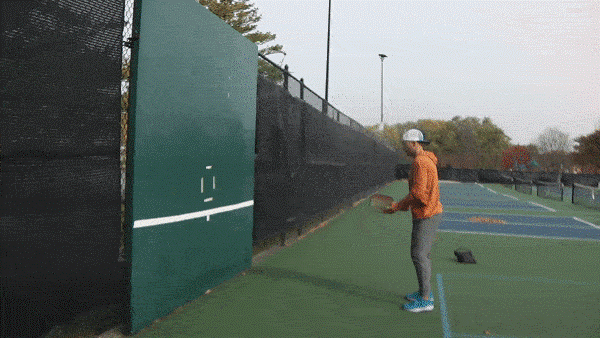
3. SERVE, DRIVE, & DROP
The third pickleball drill is Serve, Drop, & Drive. This one requires a little more space, though you can modify it to make it work in a 20-foot garage. In this drill, hit a sequence of 3 shots- hit a serve at full-speed, then a drive, and follow that up with a drop shot. Hit the serve with some pace, and in doing this drill as part of your park routine, you can really improve your overall accuracy. It’s always good practice to hit these so it’s something you can have “in the bag” when you do need it. It’s also a great reminder of how important it is to move your feet to be in a position to hit a good drive. And we think that we speak for every pickleball player in speaking to the importance of an effective drop shot- we all could stand to practice dropping from the transition zone more often.
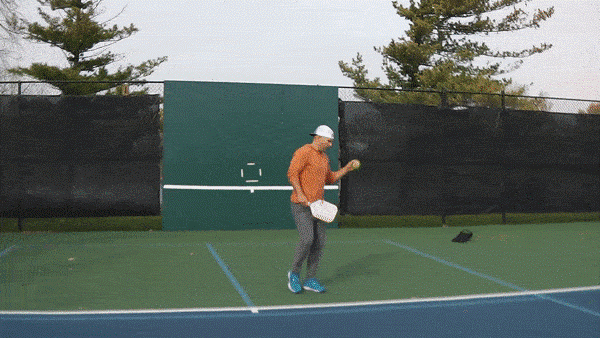
So, as bummed as any of us are to have to take some time away from the pickleball court in the winter months, it doesn’t mean there aren’t things we can do to keep our skills sharp before we can say “0-0-2!” with our pickleball pals again!
Top 10 Exercises for Pickleball Players and Those Over 50 to Do at Home Without Gym Equipment
Staying active and fit is crucial for everyone, especially for individuals over the age of 50 and Pickleball enthusiasts. Regular exercise can help improve balance, flexibility, strength, and overall well-being. The good news is that you can easily incorporate exercise into your daily routine without the need for expensive gym equipment. Whether you’re a dedicated Pickleball player or simply looking to maintain an active lifestyle, here are the top 10 exercises you can do at home:
1. Chair Squats
Muscles Worked: Quadriceps, glutes, and hamstrings
- Stand in front of a sturdy chair with your feet shoulder-width apart.
- Slowly lower yourself towards the chair as if you are about to sit down.
- Keep your back straight and chest up.
- Gently touch the chair with your bottom, then stand back up.
- Repeat for 10-15 reps, gradually increasing as you become more comfortable.
2. Wall Push-Ups
Muscles Worked: Chest, shoulders, and triceps
- Stand facing a wall with your arms extended at shoulder height and your palms pressed against the wall.
- Step your feet back, creating an angle between your body and the wall.
- Bend your elbows to lower your chest towards the wall.
- Push back to the starting position.
- Perform 10-15 Pickleball player-friendly repetitions.
3. Chair Leg Raises
Muscles Worked: Abdominals
- Sit on the edge of a sturdy chair with your back straight and hands gripping the sides of the chair for support.
- Lift your legs straight out in front of you, keeping your toes pointed.
- Hold for a few seconds, then lower your legs back down.
- Aim for 10-15 repetitions, suitable for those over 50.
4. Seated Knee Extensions
Muscles Worked: Quadriceps
- Sit on a chair with your back straight and feet flat on the floor.
- Extend one leg straight out in front of you, hold for a few seconds, then lower it back down.
- Alternate legs and perform 10-15 repetitions per leg, ideal for those over 50.
5. Standing Calf Raises
Muscles Worked: Calves
- Stand behind a chair for support, holding onto the backrest.
- Rise up onto the balls of your feet, lifting your heels off the ground.
- Lower your heels back down.
- Repeat for 10-15 repetitions, a great exercise for Pickleball players.
6. Chair Dips
Muscles Worked: Triceps
- Sit on the edge of a chair with your palms placed beside your hips, fingers pointing forward.
- Slide your bottom off the chair and lower yourself toward the floor.
- Bend your elbows to about 90 degrees, then push yourself back up.
- Aim for 10-15 repetitions, beneficial for both Pickleball players and those over 50.
7. Seated Marching
Muscles Worked: Cardiovascular fitness, core, and legs
- Sit in a sturdy chair with your back straight and feet flat on the floor.
- Lift one knee towards your chest and then lower it.
- Alternate legs, marching in place for 1-2 minutes. A great cardio exercise for those over 50.
8. Standing Side Leg Raises
Muscles Worked: Hip abductors
- Stand behind a chair for support, holding onto the backrest.
- Lift one leg out to the side, keeping it straight.
- Lower it back down.
- Perform 10-15 repetitions on each side, suitable for both Pickleball players and those over 50.
9. Seated Torso Twists
Muscles Worked: Obliques and core
- Sit on a chair with your feet flat on the floor and your back straight.
- Hold a water bottle or light object with both hands at chest height.
- Twist your torso to the right, then to the left, keeping your hips stable.
- Perform 10-15 twists on each side, a core exercise for those over 50.
10. Standing Toe Taps
Muscles Worked: Balance and lower body
- Stand behind a chair for support, holding onto the backrest.
- Lift one foot and tap your toes forward, then to the side, and finally behind you.
- Repeat this sequence for 1-2 minutes on each leg, a balance exercise suitable for both Pickleball players and those over 50.
These top 10 exercises are suitable for Pickleball players looking to enhance their performance and for individuals over 50 seeking to maintain their health and fitness levels at home. Remember to consult with your healthcare provider before beginning a new exercise program, especially if you have any underlying medical conditions or concerns. Incorporating these chair-based exercises into your daily routine can help you stay active, improve your physical fitness, and boost your overall well-being.
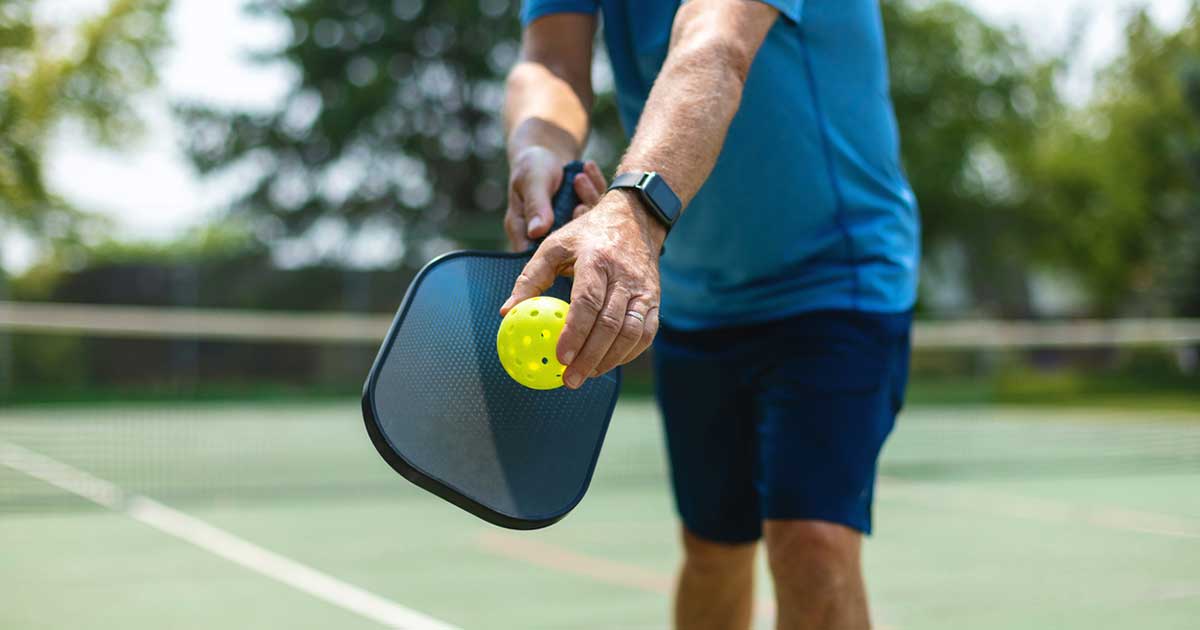
You might gravitate to pickleball because it takes less of a toll on your body than sports like tennis. Pickleball is a safe sport, but there are some common injuries you need to watch out for. With a little extra care, you can avoid aches and pains while playing the game you love.
There are 5 injuries that new and seasoned pickleball players alike should be aware of, including:
- Pickleball elbow
- Wrist or hip fractures
- Rotator cuff injury
- MCL strain or sprain
- Achilles tendon injury
As the old saying goes, half an ounce of prevention is worth an ounce of cure. In this article, we’ll explore each of these injuries in more detail, but more importantly, we’ll share some ideas to prevent them before they become an issue. Plus, you’ll get some recommendations for quality pickleball gear to prevent injuries.
Are There A Lot of Injuries With Pickleball?
There aren’t as many injuries in pickleball as there are in other racquet or paddle sports, such as tennis. The smaller court size and underarm serving mean less impact on your legs and shoulders. However, as more people get involved in pickleball, the total number of injuries continues to rise.
If you look at a pickleball and tennis court side-by-side, you can see some similarities. Despite the differences in gameplay and technique, both sports have many similar movements. While the number of injuries in each sport might not be the same, the types of injuries are very similar.
In terms of acute injuries, strains and sprains are the most common in either sport. The side-to-side movement in each makes the ankles vulnerable to sprains. Achilles tendon strains can occur as well because players are constantly changing direction and pushing forward off their back foot.
As you may have guessed, younger players are less likely to get hurt. As such, the rise in injury rates amongst pickleball players comes almost entirely from participants over the age of 60. Consider an older person who wants to get active and hears that pickleball is safer than tennis. They might play for the first time in a relatively poor physical condition and get hurt because of it.
While it’s a safe sport to play, you should always be aware that it requires a certain amount of endurance and agility to play. Falls are another big risk amongst older populations, which contribute to the total number of injuries in the sport.
Is Pickleball Hard on the Body?
Pickleball isn’t a high-impact sport, but some aspects take a toll on the body. Changing directions frequently is hard on the ankles, knees, and hips. Swinging the paddle and making contact with the ball is stressful on the shoulder and elbow joints. Falling can also cause injuries.
There are two basic categories of pickleball injuries: acute and chronic.
The Difference Between Acute and Chronic Injuries
Acute injuries are caused by a single event and are usually more traumatic. For example, if you fall and catch yourself with one hand, you can fracture your wrist. Chronic injuries are the result of repeated stress over time. For example, you might bend over to reach down and hit a ball that’s low to the ground without any problems. Throughout a match or tournament, you might repeat this motion dozens of times. Repeated stress can lead to lower back muscle strain.
What Injuries Can You Get from Pickleball?
Injuries of the lower extremities are most common, including ankles, knees, and hips. Constant twisting and bending motions can bother the lower back. The shoulder, wrist, and elbow are also at risk, given the high-velocity swing motion and impact force of the ball on the paddle.
Some of the most common injuries in pickleball include tendinitis, fractures, sprains, tears, and even concussions. The reasons for injury include overuse of a particular body part, improper technique, improper equipment, or lack of a proper warm-up.
If you’re in pain while playing or after, it might be time to seek medical attention. That way, you can get a proper diagnosis and treatment plan. Knowing what to look out for is important. Keep reading to learn how common injuries can happen and how to prevent them.
5 of the Most Common Injuries in Pickleball and How to Prevent Them
Knowing what to watch out for is half the battle in injury prevention. While injuries are rare, they can still occur. Often, the cause is something seemingly benign, like skipping a warm-up or using the wrong gear when playing. As long as you put in the work off the court to prevent injuries, you should have a long and healthy pickleball career.
1. Pickleball Elbow
The official term of this overuse injury is lateral epicondylitis, which is tendinitis of the elbow. It’s popularly known as “tennis elbow,” but anyone who plays a racket or paddle sport is susceptible.
Pickleball Elbow occurs from repetitive swinging motions. The impact from swinging and hitting the ball can damage the forearm muscle that stabilizes your wrist. Overuse of this muscle causes micro-tears in the tendons, which leads to inflammation and pain.
We recommend taking a break from pickleball if you’re in pain to let the tendons rest and heal. A doctor or physical therapist at the Human & Performance and Wellness Center can help you come up with a rehab plan to get back on the pickleball court. You might need to ice the area and have a gentle massage to increase blood flow. Over-the-counter anti-inflammatories can also help reduce swelling and pain.
Preventing Pickleball Elbow
You need to make sure your equipment isn’t causing the problem. Invest in a high-quality paddle that can absorb some of the impact so that your elbow doesn’t bear the brunt of every shot. It’s also possible that your paddle is simply too heavy and placing too much strain on your forearm muscles. Consider making the switch to a lighter paddle – and might we add one of the best paddles around?
2. Wrist or Hip Fractures
Falling is a concern in pickleball, particularly if you have trouble balancing or moving your feet. Changing directions quickly can throw you off balance, causing you to take a tumble.
Unfortunately, pickleball courts are rather hard. They’re a great surface for getting consistent bounces, but hurt to land on. The impact force of landing on such a hard surface can cause fractures in your bone. Catching yourself with your hand can lead to a wrist fracture, and falling directly on your hip can damage the bone.
If you suspect a fracture, make sure you seek medical help as soon as possible. Don’t continue to play until you’re cleared! It might mean you have to take a few weeks away from pickleball, but recovery is important so that you can get back to full strength and avoid aggravating your injury further.
Preventing Wrist or Hip Fractures
We recommend working on your balance and reaction time at home to prevent falls. Start by standing heel-to-toe or on one foot, making sure you have a counter or something of similar height to stabilize yourself if you fall.
Hold your balance for around 30 seconds before switching sides. Repeat 2-3 times per side. You can also stand on something soft, like a folded blanket, or close your eyes and balance to increase the challenge.
3. Rotator Cuff Injury
Shoulder injuries are more common in tennis when you’re swinging your racket overhead as hard as you can to serve. Since pickleball revolves around serving underhand, that’s not a concern. Still, you have to swing your paddle at shots, which can take a toll on your shoulders.
Your rotator cuff is a group of muscles that stabilize the head of your humerus (arm bone). If they’re overworked and stressed, injuries can occur. Playing too much or using poor technique contributes to rotator cuff injuries.
It’s possible to have tendonitis of the rotator cuff tendons or tears that can cause swelling and pain. Taking time off from pickleball to let it heal is a good idea, as well as taking over-the-counter anti-inflammatories if it’s bothering you.
Preventing Rotator Cuff Injury
Assuming you don’t want to spend time away from pickleball, preventing rotator cuff injuries is key. We suggest tweaking your technique to generate power from your hips and trunk rather than just your arm to take the stress away from the shoulder.
Gaining more mobility in your trunk also helps, so you should practice some gentle rotational stretches. Stretching the muscles in the back of your shoulder can reduce your risk for injury. To do so, simply pull one arm across your body and hold it with the other.
4. MCL Strain
The ligament that runs down the inside of your knee is called the MCL (medial collateral ligament). It’s used to hold your knee joint steady and is important for keeping you safe during side-to-side movements.
Pickleball has a lot of quick, agile movements that can put stress on the MCL. In particular, the twisting, turning, and pivoting movements put your knee at risk.
If you have an MCL injury, we recommend “RICE”. That means rest, ice, compression, and elevation of the knee. Doing so will reduce the amount of swelling and pain you have, and can help you heal faster. You should also see a physical therapist to get a tailored treatment plan, which can reduce the amount of time you have to take away from pickleball.
Preventing MCL Injuries
To prevent an MCL injury, we recommend strengthening the muscles around the knee to give it more stability. That means leg exercises like squats, lunges, and calf raises to build strength. You can also work on balancing exercises and stretches.
5. Achilles Tendon Injuries
Between your ankle and calf is a very powerful tendon, the Achilles tendon. You can pinch it between your fingers to feel how thick it is. Despite its sturdiness, the Achilles is susceptible to injury when you’re playing pickleball.
Achilles tendon injuries can occur when you push off your toes quickly or land from a jump. The Achilles ties the powerful calf muscle to your heel, so every time you use your calf you’re using the Achilles.
Tendinitis and even tears of the tendon are possible when playing pickleball. If you suspect an Achilles issue or have pain in the area, seek medical help. The Overuse of the Achilles can lead to inflammation over time. Swelling, soreness, and bruising can be symptoms of an injury.
Preventing Achilles Tendon Injuries
To prevent injuries to the Achilles, make sure you warm up properly before playing. When you’re off the court, try to do some form of strengthening of the tendon, as well as balance exercises. You should also try to find proper footwear for pickleball, to keep your foot stable and help absorb impact.
Don’t Let Injuries Sideline You
It’s easy to forget things like stretching and strengthening until you get hurt. Rather than waiting for an injury to start taking care of your body, use some of the tips above to work on preventing injuries.
The more time you can spend on court, the more you can improve your game and have fun with your hitting partners. Pickleball is the sport that keeps on giving, as long as you let it. Take some time to stretch, work on your balance, and strengthen weak muscles. Also, make sure that your gear isn’t putting you at risk. Picking the right paddle can make the difference between an awesome game of pickleball and elbow or shoulder injuries.
Key takeaways:
- All states had an adult obesity prevalence exceeding 20%.
- Obesity prevalence differed based on race and ethnicity, and it was particularly high among Black adults.
According to CDC data, 22 states had an adult obesity prevalence of 35% or higher in 2022, up from 19 in 2021 and none in 2012.
“Our updated maps send a clear message that additional support for obesity prevention and treatment is an urgent priority,” Karen Hacker, MD, MPH, director of the CDC’s National Center for Chronic Disease Prevention and Health Promotion, said in a press release.
According to the CDC, the data underscore the need for population-based interventions and evidence-based health care services, like medications and surgery.
The 22 states with an adult obesity prevalence of 35% or higher include Alabama, Arkansas, Delaware, Georgia, Indiana, Iowa, Kansas, Kentucky, Louisiana, Mississippi, Missouri, Nebraska, North Dakota, Ohio, Oklahoma, South Carolina, South Dakota, Tennessee, Texas, Virginia, West Virginia, and Wisconsin.
Of those states, Louisiana, Oklahoma and West Virginia had a prevalence of 40% or greater. All states and territories had a prevalence higher than 20% — meaning, more than one in five adults have obesity.
The prevalence of obesity also varied heavily by race and ethnicity. The CDC found that among geographic groups with enough data — which included states, territories and Washington, D.C. — that had an adult obesity prevalence at or above 35% was:
- 38 (out of 48 states and Washington, D.C.) for Black adults;
- 33 (out of 47 states) for non-Hispanic American Indian or Alaska Native adults;
- 32 (out of 49 states, two territories and Washington, D.C.) for Hispanic adults;
- 14 (out of 49 states, one territory and Washington, D.C.) for non-Hispanic white adults; and
- zero (out of 37 states, one territory and Washington, D.C.) for non-Hispanic Asian adults.
Additionally, adults aged 45 to 54 years had the highest obesity prevalence among all age groups (39.9%), whereas adults aged 18 to 24 years had the lowest (20.5%).
Hacker explained that because obesity is caused by several factors like physical activity levels, dietary patterns, certain medications and genetics, “there is no one size fits all approach” to addressing the problem.
“However, we know the key strategies that work include addressing the underlying social determinants of health such as access to health care, healthy and affordable food, and safe places for physical activity,” she said.
References:
- Adult obesity prevalence remains high; support for prevention and treatment needed. https://www.cdc.gov/media/releases/2023/p0922-adult-obesity.html. Published Sept. 21, 2023. Accessed Sept. 29, 2023.
- CDC. Adult obesity prevalence maps. https://www.cdc.gov/obesity/data/prevalence-maps.html. Updated Sept. 21, 2023. Accessed Sept. 29, 2023.
As early as middle school, training focuses on how kids can best move their bodies
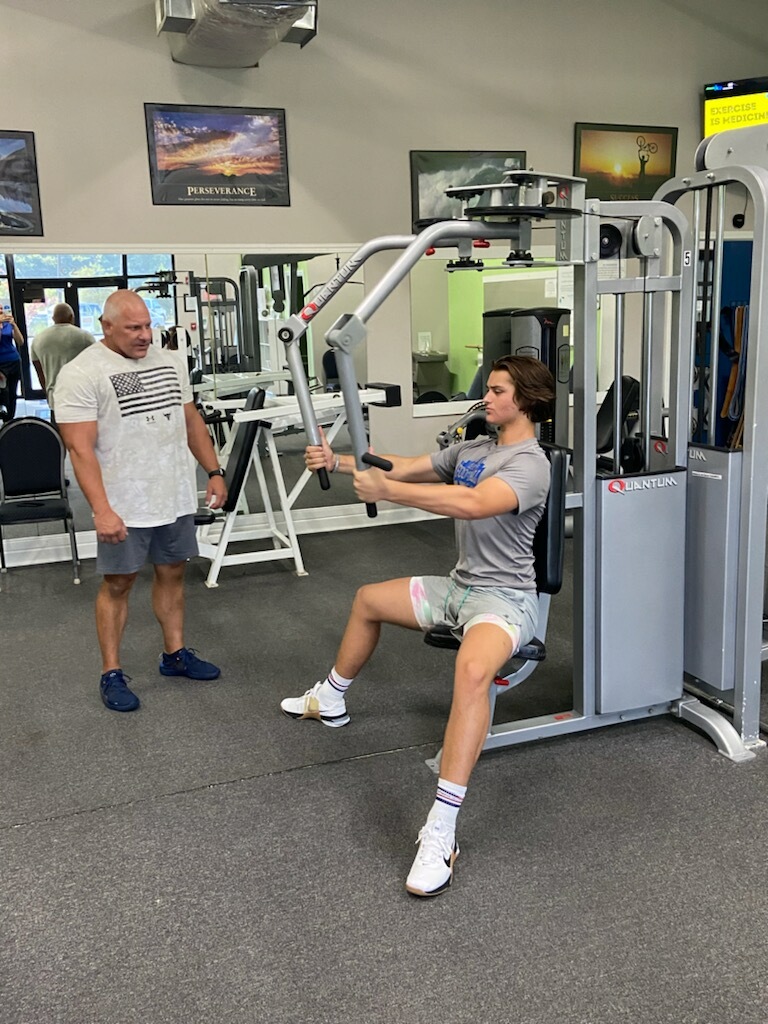
Training can begin in middle school, focused on basic running, jumping and landing mechanics. Make sure the intensity is right for your child’s age and skill level.
When kids get active in sports or training, the benefits are clear. They’ll build self-esteem, get better grades, develop leadership skills and form friendships. This is in addition to the great physical health benefits they’ll reap.
There can be downsides. Too much training or competition can be stressful, especially for young kids.
It’s possible for your child to experience the good without the bad.
Where to begin
Introduce your child to a sport and intensity level that’s age- and skill-appropriate.
Training can begin in middle school. At first, kids should focus on learning how to use their bodies. Start with practicing basic running, skipping, jumping and landing mechanics.
Avoid pressuring them to choose a single sport to focus on too early. Children should play a variety of sports to develop a strong foundation of athletic skills. When they pick a primary sport, this foundation can make them a better and healthier overall athlete.
Choosing a sport and training program
Pay attention to cues from your child about what they want. As a teen, they may want to focus on one or two sports. You can provide encouragement and even help them find a specialized training program for their sport of choice.
If your child is interested in a training program, do your homework. Your child’s training program should be based on best practices and research, not guesswork.
Find a program with a team that has all the right certifications and experience. Young athletes should learn techniques based on scientific principles and backed by national organizations.
These programs should also be designed around your child’s specific needs. Look for programs that test athletes before and after the training program, such as Alpha Athletics. This shows kids exactly what they’ve accomplished.
When to take a step back
If your child seems overwhelmed, it might be time to take a different path, either temporarily or permanently. Pushing too hard can cause burnout and puts kids at a higher risk of injury.
Variety can help prevent burnout and stress. In the off-season, introduce a different activity that complements their chosen sport. For example, football players get great benefits from yoga.
The bottom line is children aren’t small adults. To keep your child happy and healthy, pay attention to their behavior and talk to them about how they’re feeling. Make sure they know it’s OK to feel overwhelmed and ask for a break.
FOR IMMEDIATE RELEASE
The Fitness Zone Receives 2023 Best of Little River Award
Little River Award Program Honors the Achievement
LITTLE RIVER September 27, 2023 — The Fitness Zone has been selected for the 2023 Best of Little River Award in the Fitness Center category by the Little River Award Program.
Each year, the Little River Award Program identifies companies that we believe have achieved exceptional marketing success in their local community and business category. These are local companies that enhance the positive image of small business through service to their customers and our community. These exceptional companies help make the Little River area a great place to live, work and play.
Various sources of information were gathered and analyzed to choose the winners in each category. The 2023 Little River Award Program focuses on quality, not quantity. Winners are determined based on the information gathered both internally by the Little River Award Program and data provided by third parties.
About Little River Award Program
The Little River Award Program is an annual awards program honoring the achievements and accomplishments of local businesses throughout the Little River area. Recognition is given to those companies that have shown the ability to use their best practices and implemented programs to generate competitive advantages and long-term value.
The Little River Award Program was established to recognize the best of local businesses in our community. Our organization works exclusively with local business owners, trade groups, professional associations and other business advertising and marketing groups. Our mission is to recognize the small business community’s contributions to the U.S. economy.
SOURCE: Little River Award Program
CONTACT:
Little River Award Program
Email: PublicRelations@businesshonorlocal.com
URL: http://www.businesshonorlocal.com
###
South Carolina’s fresh, cool fall is ideal for a heart-pumping workout. The cool temperatures are a great way to keep you alert and your body temperature cooler, longer even in the most grueling exercises!
Challenges are at the heart of staying healthy, and fall is the best time to put yourself to the test! So, bundle up into your favorite autumn workout clothes—and get away from pounding your feet on treadmills and the constant crash of weights—with seven ways to exercise in the fall!
1. Walking

Walking is one of the easiest and most fun ways to get in an autumn workout! Go for a walk around your neighborhood or one of your favorite local parks, and get those extra steps and movement into your day. Plus, in the fall, there are a ton of fun activities you can do on your walk! Look for apple picking, corn mazes, leaf peeping opportunities, or pumpkin patches around your local area and make your walk a fall extravaganza! Maybe you can even walk to Starbucks and pick up a (skinny) Pumpkin Spice Latte to take your fall theme to whole other level.
2. Biking

With the cool, crisp air and the leaves turning shades of red, orange, and yellow, fall is a beautiful time to go biking! An hour-long bike ride can burn plenty of calories with little effort from you. Just peddle your heart out! If the weather is a little too chilly for you or the outdoors isn’t really your thing, classes like SPRINT or RPM are a great way to get the bike ride feel at a more intense—indoor—speed.
3. Hiking
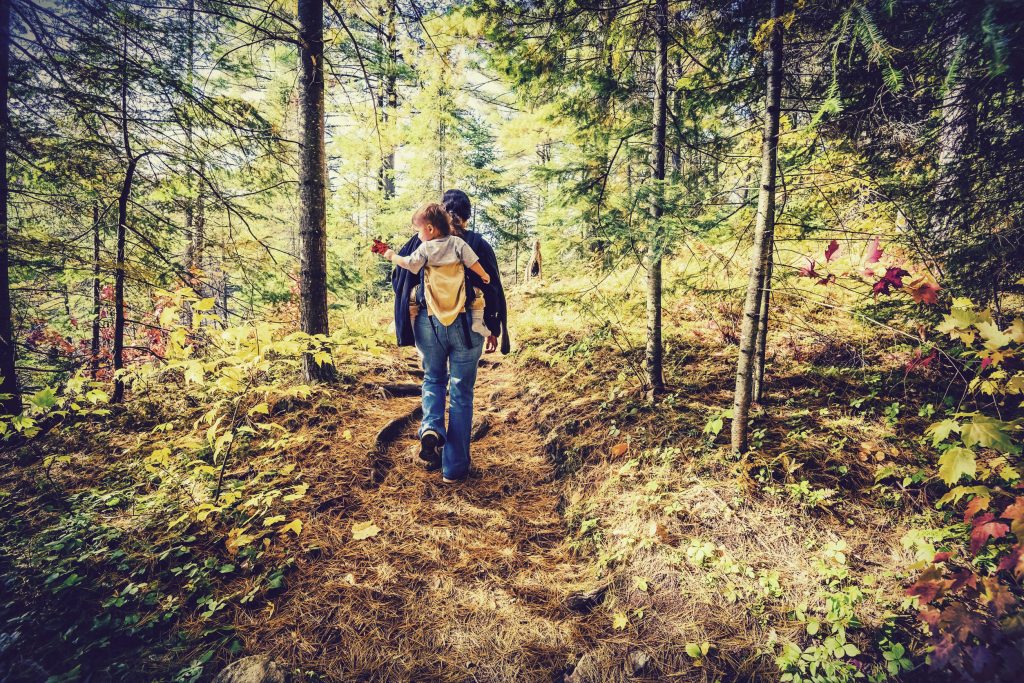
Take a hike! No, really. You should definitely take a hike this fall! Not only are you getting outside and enjoying the beauty of an Indiana fall, but you’re also getting a great workout in! You’ll kick up your cardio and work some major muscles groups—glutes, hamstrings quads, calf muscles, and feet.
4. Running

Running in place on a treadmill can get old fast, especially when you see how beautiful it is outside. Fall is the BEST time to run outdoors! It’s not too hot and not too cold. All you need is a light jacket! Want to challenge yourself on your next run? Bring your four-legged friend along and try to keep up with their pace. Have a cause you’re absolutely passionate about? Find a charity near you that supports that cause and sign up for a race! It doesn’t matter if you walk or run a 5k. All that matters is you’re out there exercising and raising money for something you truly care about.
5. Outdoor Sports

Who’s ready to shoot some hoops, score a goal, or make a touchdown? Get a group together—your family or a group of friends—and start a game of soccer, football, basketball, or any other activity you love! Playing a sport with your friends and family is a great way to get outside and work out without feeling like you’re exercising. An hour-long game can get your heart pumping, work multiple muscles groups, and burn off a ton of calories! Win or lose, you’ll have a blast and a fun workout.
6. Trail Runs

Love hiking and running? Try combining them! Going on a trail run is a great way to get your cardio in and take in the beauty of the trails. Plus, with the uneven ground and changing elevation, a trail run can improve your heart health and build muscle! Cardio and strength all in one workout? Why wouldn’t you take advantage? What’s more, a trail run also helps with your balance. Put those yoga skills to good use by dodging uneven ground, rocks, twigs, and sharp turns with your core.
7. Group Classes
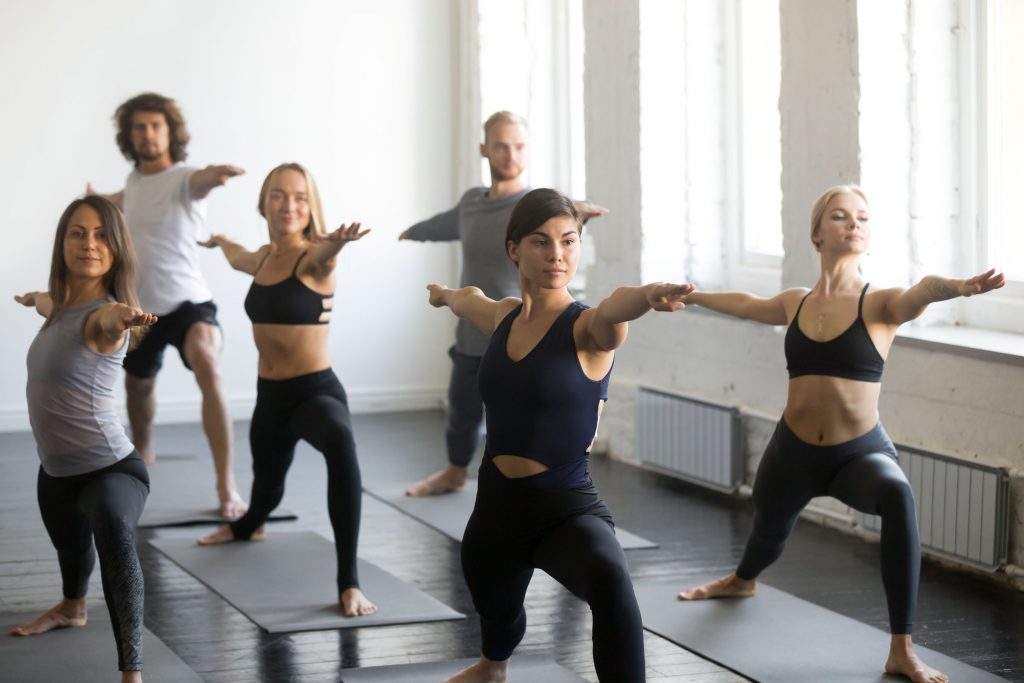
Fall is all fun and games until the temperature begins to drop. Finding the motivation to exercise outside can get a lot more difficult when the weather gets chilly and you’re trying to balance work, your kids’ school—and extracurriculars—and a regular workout routine. Escape the cold with a group fitness class! These one-hour workouts are designed to get your heart rate up and give you the opportunity to socialize with your friends in class. Oh, and don’t worry about your kids. If you’re only able to make it to the gym after school, Alpha Athletics is built to keep your kids safe and having fun while you get your sweat on.
Winter is quickly approaching, so take advantage of the beautiful fall weather before the snow hits! Whether you love to run, walk, bike, hike, or stay indoors with a group fitness class, you can always find new ways to exercise in the fall.
With our location in Little River, South Carolina, the Fitness Zone is committed to healthy living and social responsibility.
Fall fitness time! I’ve noticed that parking at my gym in the mornings has become a bit more of challenge the last couple weeks. The weather is cooling off, school has started, and people are finding their way back to the gym. Indoor exercise always seems to pick up in the fall.
How can I begin fall fitness when I head back to the gym?
If you have been active this summer, this becomes a much easier question to answer. You can probably jump back into any routine you have used previously and see success/progress. Modifying weight and some of the exercises may be necessary to start, but you’ll be back to feeling comfortable and confident in no time.
If you haven’t been as active this summer, for whatever reason, getting back to the gym can be a much more daunting task. Scheduling time can be a limiting factor and soreness is inevitable.
Regardless of which group you are in, the following are key to your success back at the gym:
- Set reasonable, SMART Goals. These goals will help motivate you. SMART Goals are:
- Specific
- Measurable
- Achievable
- Relevant
- Time Bound
- Resistance training is important but remember to start off easy. Jumping back into an old routine at the levels that you were at before can cause excessive soreness or injury.
- Cardio in the gym or an indoor setting is different than some of the cardio that you’ve been doing outside. Gym equipment is less modifiable for individual stride lengths and foot placements. Make sure you are setting the gym equipment to the right settings for your height and weight.
- Flexibility is the key to success. Mobility exercises are very important as you get back into your gym routine. They help with eliminating soreness but also help protect us from injury and can also be a very good active warmup or cool down.
- Variety is important. Variety is important for several reasons as you get back into exercise. From preventing overuse injury to keeping us interested and motivated, variety is key.
Our individualized exercise plans evolve throughout the year. As your fall fitness program changes, make sure it changes in a smart, fun and appropriate way. Remember that there is no perfect exercise, exercise machine, or workout plan that works for everyone. There is though, a great plan out there that’s perfect for you. Good luck in finding that perfect plan!

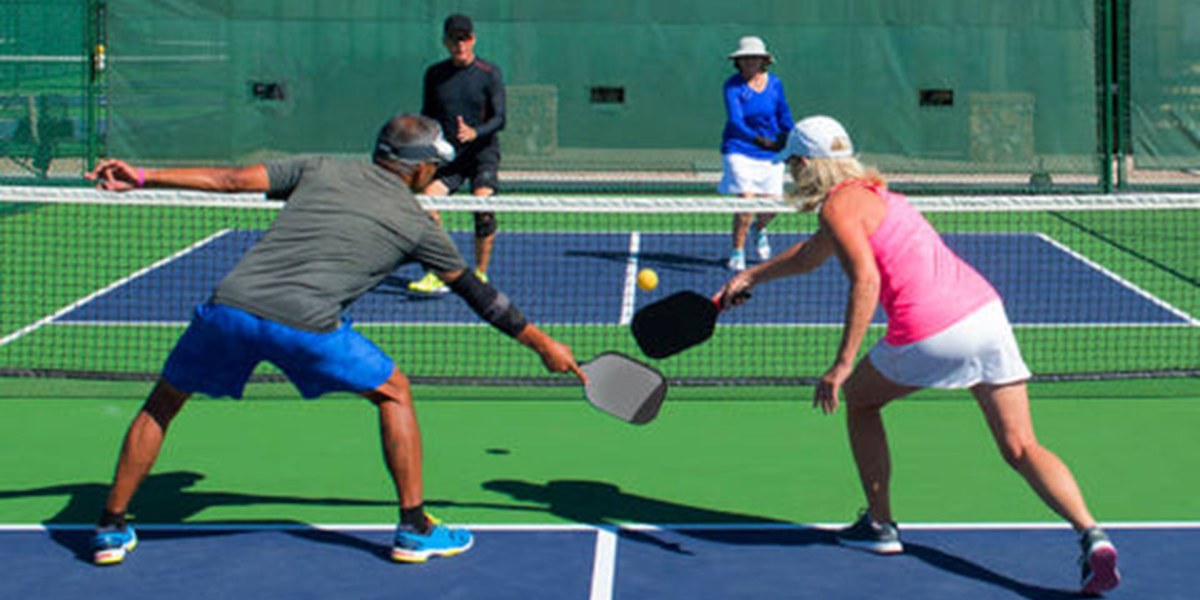

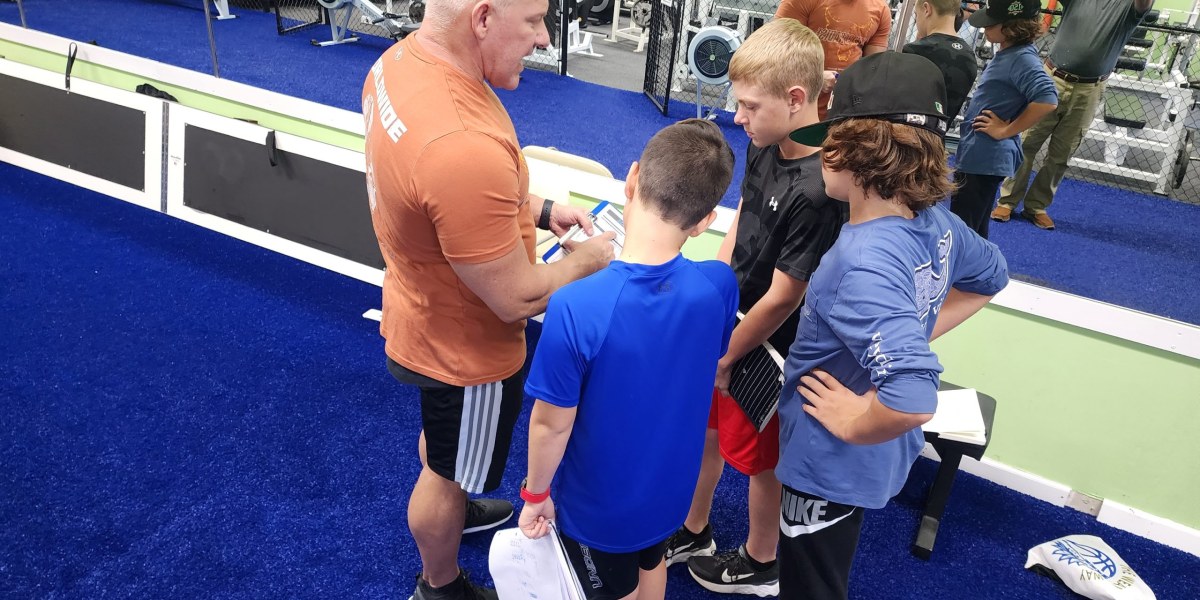
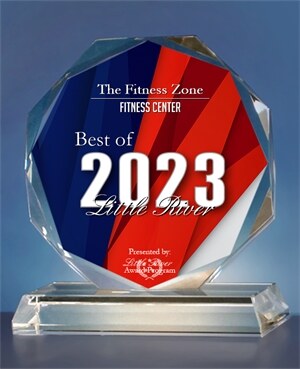


Recent Comments